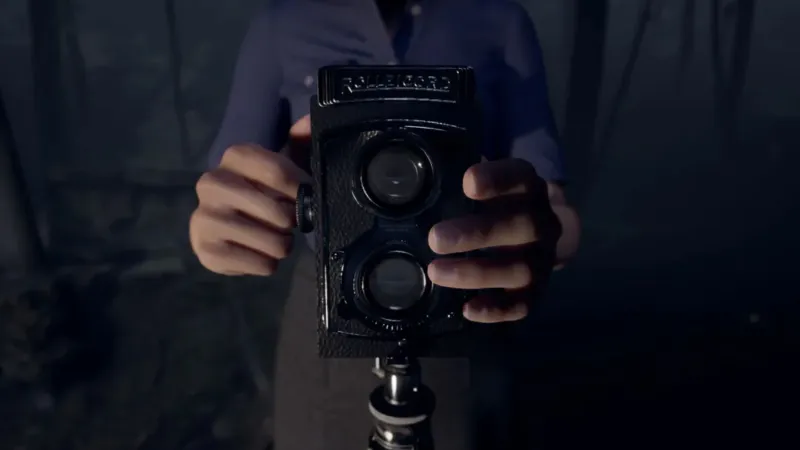Martha Is Dead starts off extremely strong and immediately introduces a dynamic between twin sisters Martha and Giulia that sets the stage for the entire game. Giulia’s mother never loved her the way she loved Martha, and that relationship, or lack thereof, has been eating away at Giulia’s mind for years. After Giulia finds Martha drowned in a lake, her mother runs to hug Giulia, mistakenly believing her least loved child has perished. She’s finally getting the love and affection she’s always wanted. What happens next is unexpected, even mind-blowing, and I was immediately drawn into the premise. Unfortunately, Martha Is Dead is quickly becoming a chore.
I felt at odds with the gameplay when I first started exploring Giulia’s family mansion. Walking feels like trudging through mud, which is especially frustrating as this game is all about walking around and interacting with objects to learn more about what’s going on. Occasionally you’ll run through poorly explained dream-like scenarios or take part in simple mini-games, e.g. B. by using a camera and its photos to find answers as to who was at the lake the night of Martha’s death. Most of the time, however, you walk a lot and look at a lot of things. One scenario has you dodging an enemy, which adds excitement that I would have liked to see in other areas of the game. However, since you’re mostly running, the game feels less like traditional horror and more like watching a story that happens to be horrifying in nature.
To make matters worse, interacting with objects is also boring. Pressing the right thumbstick reveals interactive objects, which quickly becomes tedious as the onscreen icons disappear in a matter of seconds. As a result, I kept pressing the right thumbstick. As if to make this annoyance an even bigger stumbling block, the controls change completely in some cases. Instead of interacting with an object by pulling the trigger, you inexplicably have to press A. These frustrations, coupled with bugs that halted progress, began to shatter the initial fascination I felt during the opening.
Interacting with some objects, like letters or your dead sister’s body, leads to side objectives. None of these are as engrossing as the main mystery, but a handful of side tangents are serviceable, like one I found using a tire pump to unlock a bike, which made mansion travel a bit quicker. For some, I had to use an in-game camera, which can be outfitted with accessories that change how the camera is used, and skins, which are collectibles that are purely cosmetic. I enjoyed the mechanics around the camera’s focus, distance, lens types and more e.g. B. the need to use the directional pad very slightly to focus an image. I was glad that the camera was also such a big part of the main goal. The game’s darkroom, which required me to develop my photos the old-fashioned, realistic way using a timer and the controller sticks, made using this camera even more immersive.
Despite some compelling segments, many goals are half-baked or poorly explained. For example, I spent 30 minutes looking for a side quest key (or so I thought) only to later realize I couldn’t get it until I completed a key story moment much later in the game. I wish LKA had better pointed out when you can’t progress in a quest until you’ve progressed through the main story.
For a game that relies so heavily on narrative, Martha Is Dead’s story rubbed me the wrong way in many ways. Some of the key moments in the game ask you to sympathize with Martha and Giulia’s parents: a Nazi general and a woman who doesn’t seem surprised to be married to a Nazi. I particularly enjoyed helping Italian resistance forces defeat Nazis near my family’s villa. Oddly enough, the game asked me if I wanted to help the Italian resistance fighters or thwart their plans by telling my Nazi father about it. Of course, I did not consider this option. LKA wove some big narrative threads into the family dynamic, but I didn’t connect with them because ultimately I would never sympathize with a Nazi.
In these moments I was comforted. There are ways games used Nazis to tell interesting stories, but it wasn’t that. Martha Is Dead doesn’t praise the Nazis or even show support for them, but the family’s Nazi connection plays into nothing other than the fact that World War II is taking place. The parents are only used to add to Guilia’s torture and trauma, but her Nazi beliefs play no role in this. Why are they Nazis and why does it matter in Martha Is Dead that they are? These are questions I would have liked to have answered. LKA uses the war over this villa to demonstrate the influence Nazi Germany lost on Italy in 1944 and Giulia’s father eventually faces consequences for his part in it, but instead of using this moment to show he gets what he deserves is instead Martha Is Dead uses this narrative beat to further torment Giulia.
Unfortunately, Martha Is Dead never went beyond superficial depictions of war. Martha Is Dead tries to combine psychological horror and the horrors of war in a compelling way, but because one half of that equation falls short, the two never come together to create anything truly satisfying. The story leans toward gore and disturbing imagery, prompting me to do things more gruesome than anything I’ve done before in a game, but those moments don’t meaningfully add to the narrative or experience. I felt like the blood was there just for the shock value.
Martha is Dead is not about war, but about the central mystery of how Martha died. There are some supernatural elements in the game and some compelling revelations. Too often, however, Martha Is Dead uses the “your memories tell you” trope just before a big reveal about how events really played out. Those cheap twists are disappointing every time because they don’t feel deserved.
Without spoiling the story, I ended the game dissatisfied and confused with everything I was playing. This was particularly unfortunate because the initial premise was so compelling. The execution of the story twists and the way the game touches on some serious mental health issues was disappointing. As the credits roll, the game will pop up a message that if you need help, something Giulia couldn’t do in Martha Is Dead. While that’s true, it felt more like a sticker stuck on this game, which in the previous six hours never made any real or meaningful commitment to exploring those feelings in a respectful and sensitive way.
LKA created the best recreation of an Italian setting I’ve ever seen in a game and I wanted nothing more than to enjoy it. However, LKA’s love for Italy is the only warmth I felt in Martha is Dead. The rest left me as cold as Giulia’s dead sister.








